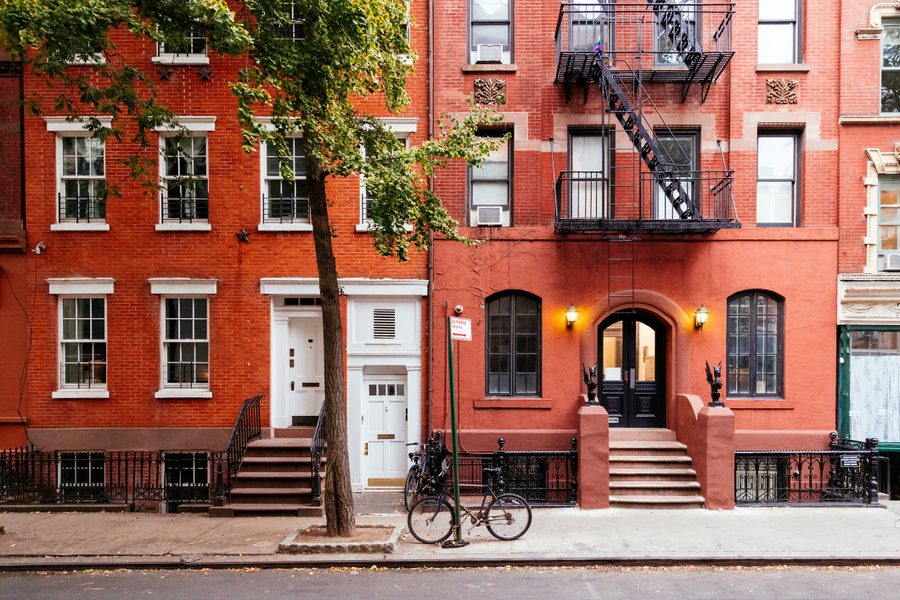One Weird Trick to Help Solve the U.S. Housing Crisis
In a new book, Richard Kahlenberg explains that decades of arcane zoning regulations have led to our current system of high rents, restrictions on worker mobility, and racial and economic segregation.
Max B. Sawicky

In America, where you stand depends on where you sleep, and the rent is still too damn high. While much mainstream media attention has focussed on the profound threats to U.S. democracy ahead of the 2024 elections, this approach tends to overlook the machinery of inequality that hums along behind the scenes. A primary way this inequality is enforced is through the process of zoning.
This issue, which is constituted by arcane regulation and litigation, is the subject of Richard Kahlenberg’s latest book, “Excluded: How Snob Zoning, NIMBYism and Class Bias Build the Walls We Don’t See.”
Zoning may provoke instant reactions of eyes glazing over (or TL;DR) but we shouldn’t kid ourselves. This is a subject of paramount importance, fundamental to both systemic racism and wealth inequality in the United States. Donald Trump recognized the salience of zoning in his failed overture to voters “living their Suburban Lifestyle Dream.”
Exploitation runs on two levels. The one that most progressives see, talk about, and fight over includes the labor market and public policy, each operating at national levels. The other is the consequence of residential segregation by race and class that has profound effects on individuals’ economic well-being and chances in life, insofar as both depend on housing affordability.
We could compartmentalize housing policy in four boxes. The Left usually works on legislation and related litigation, rent control or initiatives around social housing. Kahlenberg analyzes a fourth: deregulation. Chances are there is no politically plausible, big, single reform that fixes everything, so all of these avenues need to be worked on.
Contrary to nostrums about the United States as a free market paradise, supply of the most important asset for most people — their home — is rationed and highly regulated. Restriction of housing supply levies an implicit tax on the purchase of residences, possibly in the range of 40 percent.
One’s place of residence determines access to public schools. Laws may restrict families to schools in their own neighborhoods, which is why housing policy is often equated to education policy. Parents have been jailed for trying to sneak their children into a better school outside their district. The draconian penalties rival those for voter fraud in red states, but the crimes in question here often take place in heavily-Democratic locations.
Neighborhoods that are safer with better schools afford children better labor market prospects for the rest of their lives. Homes in such locations will tend to appreciate in value, helping families to build wealth. Unsafe neighborhoods with poor schools and little scope for home ownership are at the root of the stubborn, enduring gaps in wealth between Black and white families.
The long-standing debate in education policy used to be about whether, or how much, money mattered in school quality and educational attainment. More recent research finds an important role for what economists call “peer group effects.” Students from poor families do better in schools that are integrated by class, while their classmates do just as well.
More broadly, restrictions on housing supply restrict worker mobility. The inability of workers to relocate in order to take better jobs wreaks an enormous cost to the nation’s economic output.
Zoning is generally under the purview of local governments, a feature of the federal system bequeathed to us by our patrician, slave-owning founders. That the United States has the most decentralized public sector in the world was hard-wired into the Constitution, leading to a myriad of obstacles to populist policies such as the redistribution of wealth away from those aristocrats and oligarchs.
What may surprise readers is Kahlenberg’s report of a recent reduction in segregation by race, and an increase in segregation by class. At the heart of segregation in both cases are restrictions on the supply of residential housing due to zoning. A century of litigation and political struggle have broken down walls to racial segregation, to some extent, while the courts have been stubbornly resistant to challenge segregation by class.
It’s not just the rich who are on the hook for this situation. Restrictive zoning is also a practice in otherwise liberal communities, nor are preferences for such obstacles always forsaken by people of color.
The exclusionary effects of zoning result from stipulations that single-family housing be constructed on lots of minimum size, and bans on multi-family units, “Accessory Dwelling Units” (also called carriage houses or “granny flats”), “manufactured housing” and mobile homes. The lot size restriction renders lower-cost housing unprofitable for developers. As Kahlenberg recounts, zoning regulations can be especially subtle and effective in preventing undesired construction without appearing to reflect any bias. This is because regulators determine the exact scale of development or housing density required for profitability, and block everything beyond that level.
Back in the early 20th Century, the United States enforced legal obstacles to housing purchase by African-Americans through such policies as restrictive covenants. As documented by writer Ta-Nehisi Coates, to buy a house under these terms required the purchaser to refrain from selling to an African-American. Such practices, as well as explicit, legal barriers to racial integration, have been substantially swept away. But restrictions according to income and wealth have taken their place, to similar effect. As Critical Race Theory illustrates, systems that are race-neutral on their face can still have disparate effects by race.
Zoning is such a tangle that fixing it is not easy. First of all, there’s the politics. Suburban liberals may reject discrimination by race, ethnicity, gender or sexual orientation. But their housing equity is usually a large share of their total wealth, perhaps the fruit of their life savings. Some say their house is their 401(k). Fears of any loss of house value often lead to rejection of zoning reform. This is a double-edged sword. As Kahlenberg notes, “The flip side is that one person’s outsized property appreciation gains is another person’s housing affordability crisis.”
Housing supply restrictions also burden renters by pumping up monthly rents. One notorious type of discrimination is the practice of rejecting applicants whose ability to afford monthly rent is due to Section 8 Housing Vouchers. The racial impact should be clear, though such discrimination can be perfectly legal.
In my own area of Loudoun County, Virginia, this battle is on full display under the heading of “smart growth.” Loudoun is one of the fastest growing counties in the United States, and also one of the wealthiest. We have a multitude of families in single family homes on very large lots who do not favor continued development and population growth. Some areas are zoned so that a single lot must be at least 20 acres.
Anti-growth arguments are sometimes couched in environmental terms, perhaps sincerely held. A common slogan is “to preserve our traditional way of life.” (Traditional meaning before all those new people, many of them immigrants and people of color, came here.) In urban areas, zoning may be upheld by liberals as a defense against gentrification, or for the sake of historic preservation.
Here in Loudoun, our Democratic politicians walk along a knife’s edge between constituents in slightly denser areas and wealthy liberals on one or two-acre lots. Our less-rich, rural, white working-class residents have largely migrated to the Republican Party. Zoning reform is left a turd in the Democrats’ punch bowl.
Nevertheless, Kahlenberg provides a raft of potential reforms, and political arguments to support them. His claims are all extensively documented by research in some 80 pages of endnotes (it gets technical very quickly).
The nature of this briar patch favors the forces opposing change. The heart of resistance typically comes from upscale, suburban homeowners, mostly white, who fear reductions in their real estate value, increased traffic and higher taxes to pay for the expansion of school enrollments. Opposition can also come from realtors or developers who benefit from an imposed scarcity of housing.
These forces easily mobilize homeowners to pack public hearings. They can afford to deploy technical experts. The conservative-minded typically oppose zoning reform by default, but the appeals to environmental quality and historic preservation can rally a crucial margin of liberal opposition.
One potential solution is to replicate relatively successful reforms pertaining to racial discrimination in order to combat class discrimination. Perhaps the foremost example is the Fair Housing Act of 1968, which was focused on racial exclusion. One could pick up the text and modify it to replace race with income and generate a second “Economic Fair Housing Act.” Such legislation would make possible civil suits that knock down zoning restrictions and enable residential integration.
There are possibilities for bipartisan support behind zoning reform. Commercial interests would like to build anything they want, anywhere, though they can be dangerous allies. Property owners itching to sell and relocate could be sympathetic. Land held in reserve for farming could be worth a fortune if development, even of single-family houses, was permitted. Courts may be saturated with Republican judges, but conservatives can be hostile to regulation, and zoning is regulation.
Another possible source of political support for reform is to suggest to families that their children be able to buy homes in the areas where they grew up. Another is to allow “granny flats,” sometimes called “Parents in my backyard” or “PIMBY,” that allow the elderly to live near their children. (Kids, however, may feel differently about this…)
There are success stories recounted in detail by Kahlenberg that activists would do well to study, as well as failures. On the failure side was the unsuccessful attempt at housing reform in blue California, where astronomical housing prices remain a scandal. On the bright side have been efforts in Minneapolis and Oregon.
In 2018, after prolonged agitation, the Minneapolis City Council ended single-family house zoning citywide in one fell swoop, legalizing duplexes and triplexes. And in 2019, the state government of Oregon banned single-family housing statewide, in towns exceeding a population of ten thousand. There have also been positive changes in Charlotte, North Carolina, and proposals for change in Virginia, Nebraska, Florida, Maine and Maryland.
I do have a few bones to pick with Kahlenberg. He suggests that homeownership is a unique way to build wealth, and restricting it is a source of the racial wealth gap. It is true that tax policy subsidizes home ownership (less than previously thanks to the Trump-era tax reforms), and the subsidy increases with the taxpayer’s income. Racial impacts follow from that. But that subsidy does not necessarily increase over time.
Research finds that stock market returns exceed appreciation in home equity over the long run. Of course, there are other benefits to home ownership not captured in housing prices. One is that holding a mortgage provides a discipline for the homeowner to save, in the form of paying down the mortgage. A person could resolve to contribute regularly to their IRA or 401(k), but it’s much easier to steal from your own contributions than to meddle with monthly mortgage payments.
The bigger issue is that the U.S. system that bases retirement income on individual savings, whether in IRAs or home ownership, is a dismal failure. An ample system of public pensions would be a worthwhile replacement for the risky reliance on the stock market or home ownership.
Another theme in the book reflected in the title is the role of snobbery, or “classism.” As many have pointed out, the partisan divide in the United States has shifted from class to educational attainment. Support for income segregation rides on similar, ordinary prejudices held against people of color by whites.
This is a little discomforting. Increasing income inequality and precarity makes homeownership more of a struggle, but also more of a priority to defend, once one has attained it. The upwardly-mobile may take it for granted less than those who have never faced financial insecurity.
Ill-considered development can bring down property values. Concerns for the environment and gentrification can be real. Trust in a promise of wise development, respectful of the interests of all parties affected, can be risky. Regulation via zoning is planning, untangling that is planning as well. And planning is hard.
Stepping back, we could say that the current regime of labor standards is out of sync with housing supply, hence the housing affordability problem. Work does not pay enough to support housing affordability, which is crucial to raising a family. The stagnation of wages over time creates a particular dilemma for younger workers aching to start families and get into their own home. Restriction of housing supply makes it all worse. The U.S. federal system of local control makes fixing anything more difficult than it is in most other countries, where national governments control housing policy.
Housing reform, which among other things entails zoning reform, is a tough nut to crack in the United States. That makes the issue all the more important, since it underlies major problems facing the U.S. working class.
Max B. Sawicky is an economist and writer in Virginia, formerly with the Government Accountability Office and the Economic Policy Institute. He is a Senior Research Fellow at the Center for Economic and Policy Research and runs the MaxSpeak, You Listen! blog at sawicky.substack.com.








